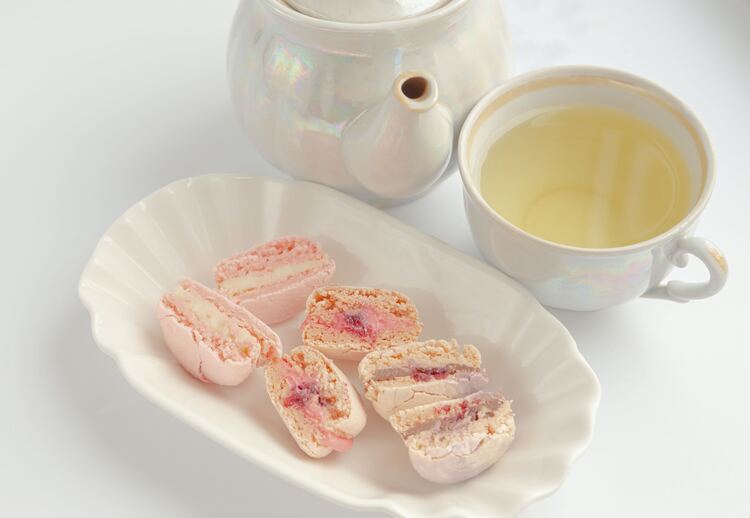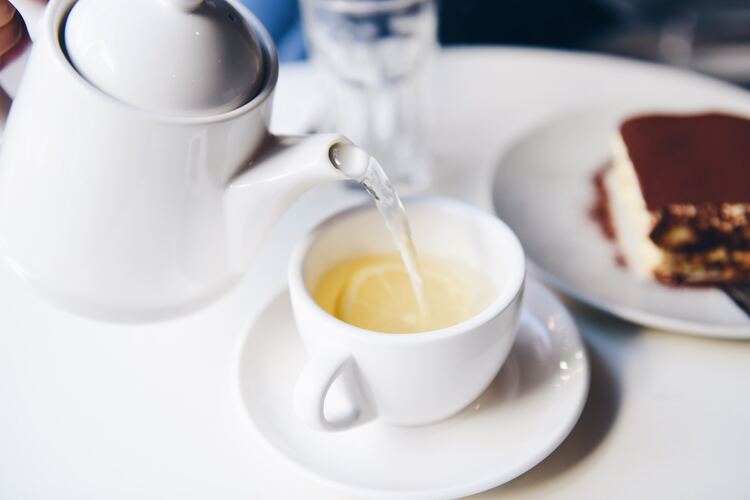What does white tea taste like?
White tea generally has a mild flavor with a delicate sweetness and a hint of floral notes. The taste can vary depending on the specific type of white tea and how it’s processed, but overall, it tends to be lighter than other tea varieties. This is because white tea leaves are minimally processed, retaining their natural flavor and not being subjected to oxidation, which can impact taste.
In this article, we go deep into the flavor profile of white tea, factors affecting taste, brewing techniques and health benefits.
Please note: This article contains affiliate links, meaning I may earn a commission if you make a purchase by clicking a link. Of course, this comes at no extra cost to you and helps me to keep offering solid information to readers.

What Is White Tea?
White tea is one of the most delicate and pure teas available. It gets its name from the white fuzz on the young tea buds, which gives the leaves a slightly silvery appearance.
Origin and History
White tea has its origins in China, specifically in the Fujian province. The production and consumption of white tea dates back to the Tang Dynasty (618-907 AD). It was considered a luxury for the emperor and the royal court due to the rarity of the young buds required for its production.
Traditionally, the tea leaves were picked in the early morning and immediately sun-dried. This prevented the oxidation process, resulting in a minimal change to the flavor profile and appearance of the leaves. The production process has remained relatively unchanged for centuries.
Today, white tea is enjoyed by tea enthusiasts worldwide, and its popularity has led to the production of white teas in other countries, such as India, Sri Lanka, and Nepal. However, Fujian white teas are still highly prized among connoisseurs.
What Does White Tea Taste Like?
We’ve brewed countless cups of white tea and noted the various flavor nuances unique to this tea type. In this section, we’ll dive into the key flavors and mouthfeel that characterize white tea, as well as the factors influencing its taste.
Key Flavors
White tea boasts a delicate and subtle flavor profile that can vary depending on the specific type and quality of the white tea. Here are some common flavors you may encounter:
- Citrus: A refreshing hint of lemon, orange, or grapefruit can be found in white teas.
- Floral: Floral notes like jasmine, rose, or honeysuckle impart a delicate sweetness to the tea.
- Fruity: Stone fruits like peach, apricot, or plum may be present in the tea, giving it a juicy and sweet taste.
- Grassy: Some white teas offer a mild, grassy flavor, reminiscent of fresh hay or alfalfa.
- Herbaceous: White teas often have subtle herbaceous undertones, possibly accompanied by hints of fresh mint or sage.
Mouthfeel
White tea is typically very light in body with a soft, smooth texture. It should never be bitter or astringent if brewed correctly. Some higher-quality white teas may possess a gentle creaminess, while others can be quite crisp and refreshing.

Factors Influencing Taste
From the processing methods to the environmental factors, a myriad of elements can impact the taste and flavor of white tea. These include:
- Processing methods: From the plucking of the tea leaves to the drying process, each production stage can greatly affect the final taste of white tea.
- Terroir: The climate, soil, and altitude of the region where the tea is grown all contribute to the unique taste of each white tea.
- Tea type: Different types of white tea, such as Bai Hao Yin Zhen (Silver Needle) or Bai Mu Dan (White Peony), each offer distinct flavors and aromas.
- Age: Just like fine wine, the quality and taste of white tea can evolve over time. Some white teas may even develop richer, earthier flavors as they age.
With these varying factors in play, white tea delivers a truly unique and alluring experience for the tea enthusiast.
Types of White Tea and Their Tastes
In this section, we will discuss the different types of white tea and their unique flavors. Let’s dive into the four main varieties:
Baihao Yinzhen (Silver Needle)
Baihao Yinzhen, or Silver Needle, is considered the highest quality white tea. It is made from the unopened buds of the tea plant, which gives it a delicate, light flavor. The taste of Silver Needle is characterized by subtle floral notes, a creamy mouthfeel, and a lingering sweetness.
Bai Mudan (White Peony)
Bai Mudan, or White Peony, is another popular variety of white tea. It consists of both the buds and the young leaves of the tea plant. Its flavor is more robust than Silver Needle, but still delicate and light. White Peony has a mild, creamy taste with hints of fruit and a slightly earthy undertone.
Gong Mei (Tribute Eyebrow)
Gong Mei, also known as Tribute Eyebrow, is a lesser-known variety of white tea. It’s made from more mature leaves than Silver Needle and White Peony but still offers a delicate flavor. The taste of Gong Mei is characterized by its nutty, slightly sweet notes and a refreshing touch of astringency.
Shou Mei (Longevity Eyebrow)
Shou Mei, or Longevity Eyebrow, is the final variety we will discuss. Made from the tea plant’s more mature leaves, it has a stronger flavor than the other varieties. Shou Mei’s taste is fruity with hints of honey and a slightly more pronounced astringency. This variety is perfect for those looking for a bolder white tea experience.

White Tea Brewing Methods
Brewing white tea is a delicate process that requires attention to detail to extract the subtle flavors and aromas without overpowering them. Here’s a basic guide on how to brew white tea:
Ingredients and Tools
- White tea leaves
- Fresh, filtered water
- Teapot or a brewing vessel
- Tea infuser or disposable tea bags (optional)
- Tea cups
- Timer
- Kettle or pot for boiling water
Steps
- Water Quality: Start with fresh, high-quality water. Avoid using tap water with strong odors or flavors, as it can affect the taste of the tea.
- Heating Water: Heat the water to about 175°F to 185°F (79°C to 85°C). This is below boiling point, which helps preserve the delicate flavors of white tea. To achieve this, you can use a thermometer or let the boiling water cool for a few minutes before pouring it over the tea leaves.
- Measuring Tea: Use approximately 1 to 1.5 teaspoons of white tea leaves per 8 ounces (240 ml) of water (or 1 tea bag per o ounces of water). You can adjust the quantity according to your taste preferences.
- Pre-warming the Teapot: Pour a small amount of hot water into the teapot to warm it. Discard this water.
- Adding Tea: Place the white tea leaves into a tea infuser or disposable tea bag, if you’re using one. Then, place the infuser or tea bag in the teapot.
- Pouring Water: Once the water has reached the appropriate temperature, pour it over the tea leaves in the teapot.
- Brewing Time: White tea requires a shorter brewing time compared to other types of tea. Start with a brewing time of around 2 to 3 minutes. You can adjust this based on your taste preferences. Be cautious not to overbrew, as this can lead to bitterness.
- Observing the Leaves: White tea leaves often unfurl during brewing. Take a moment to appreciate the leaves and their transformation.
- Pouring the Tea: After the desired brewing time, carefully pour the brewed tea into the tea cups. You can use a strainer to catch any loose tea leaves if you didn’t use an infuser or tea bags.
- Multiple Infusions: White tea leaves can often be infused multiple times. Increase the steeping time slightly with each subsequent infusion, as the leaves will have started to open up more.
- Savoring the Flavor: White tea has delicate and nuanced flavors. Take the time to savor the aroma and taste. You might notice subtle floral, fruity, or slightly sweet notes.
Remember that these are general guidelines, and the optimal brewing method can vary based on the specific type of white tea you have. If the tea tastes too weak, you can increase the amount of tea leaves or steeping time. If it’s too strong or bitter, reduce the steeping time or lower the water temperature.
Loose Leaf vs. Tea Bags
Loose-leaf white tea is generally of higher quality and tastes richer than tea bags. The full leaves in loose-leaf tea allow for better water circulation and more room for the leaves to expand, resulting in a more flavorful brew. On the other hand, tea bags often contain smaller, broken leaves and may introduce unwanted flavors, such as those from paper or other packaging materials.
We recommend using loose-leaf white tea for the best flavor experience. If you prefer tea bags for convenience, choose high-quality, biodegradable bags from a reputable brand.
Health Benefits of White Tea
White tea is not only a delicious beverage but also offers numerous health benefits. In this section, we’ll highlight some key advantages of incorporating white tea into our daily routine.
Antioxidants
One of the most significant benefits of white tea is its high antioxidant content. These natural compounds help protect our body from damage caused by free radicals, which can lead to chronic diseases and aging. Since white tea is the least processed tea variety, it preserves more of the tea’s natural antioxidants.
Cardiovascular Health
Regular consumption of white tea may contribute to improved cardiovascular health. The antioxidants present in white tea aid in reducing inflammation, lowering cholesterol levels, and relaxing blood vessels, which ultimately supports healthy blood pressure and heart function.
Weight Management
White tea has the potential to aid in weight management. Due to its catechins and caffeine content, it may help increase metabolism and fat oxidation. This can result in a natural, mild boost of calorie-burning potential, making white tea a lovely addition to our healthy lifestyles.
We hope that these health benefits will encourage you to give white tea a try and enjoy the distinct flavors while reaping its various advantages to our overall well-being.

White Tea Food Pairings
When it comes to pairing white tea with food, it is important to choose foods that complement its delicate flavor profile.
Here are some good food pairings for white tea:
- Fresh fruits: White tea goes well with fresh fruits such as berries, melons, and citrus fruits. The natural sweetness of the fruits complements the subtle flavor of white tea, creating a refreshing and healthy combination.
- Light pastries: White tea pairs well with light pastries such as scones, shortbread cookies, and angel food cake. The mild flavor of white tea doesn’t overpower the delicate flavors of the pastries, making for a perfect afternoon snack.
- Seafood: White tea also pairs well with seafood such as shrimp, scallops, and white fish. The light and delicate flavor of white tea complements the lightness of seafood dishes, creating a harmonious balance of flavors.
- Salads: White tea goes well with salads that have light and fresh ingredients such as greens, cucumbers, and tomatoes. The subtle flavor of white tea doesn’t overpower the flavors of the salad ingredients, making for a refreshing and healthy meal.
- Cheese: White tea pairs well with mild and creamy cheeses such as goat cheese and brie. The delicate flavor of white tea complements the rich and creamy flavors of the cheese, creating a delicious and satisfying combination.
White Tea Buying Recommendations
If you have not tried white tea, I hope the article instills the desire to do so. I highly recommend it! Here are our top recommendations:
Davidson’s Tea Bulk, White Peony

VAHDAM, Imperial White Tea Leaves


Prince of Peace Organic White Tea


I hope you have enjoyed the article. Let me know what your thoughts are about white tea. Cheers!
To you, what does white tea taste like?
More About Tea
What Does Black Tea Taste Like?
What Does Green Tea Taste Like?